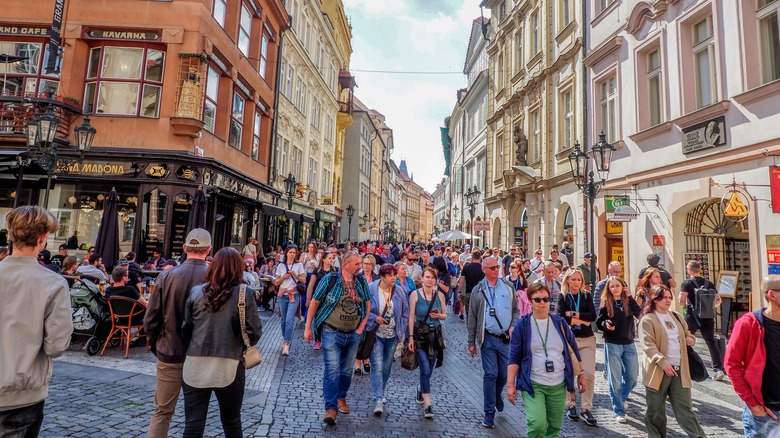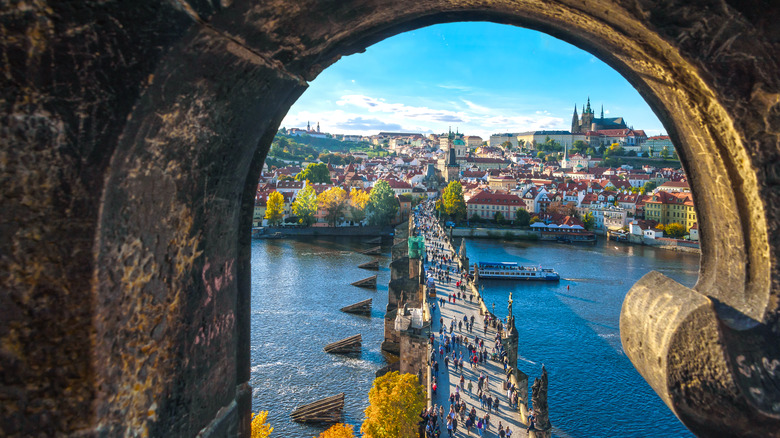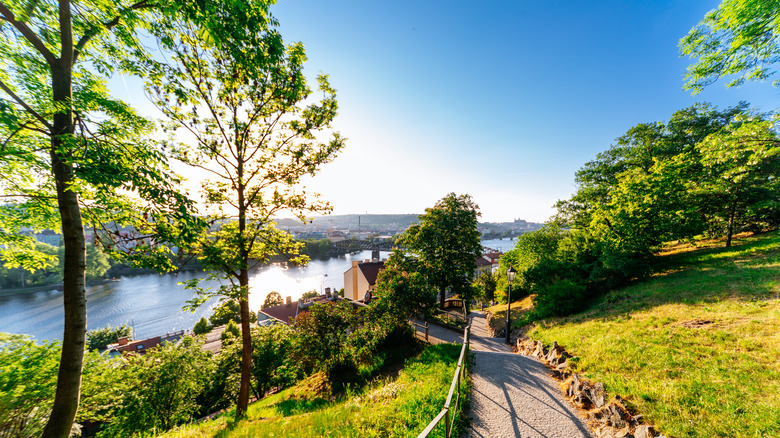A Graceful European Capital Once Called 'The Paris Of The '90s' Is Crowded And Wildly Overtouristed Today
It's always disheartening to visit a place that you used to love and see it changed for the worse. Some cities across the globe are ancient enough to seem unchangeable, like Rome, with its deep history and dense historical sites. In other cases, it's hard to describe how a place changed beyond its "vibe" being different. In some cases, overtourism and overcrowding can ruin a beloved location to the point that it becomes unrecognizable compared to what it once was. Such is the case with the heart of Prague, the capital of Czechia that was once known as the "Paris of the '90s."
Prague's major downtown landmarks still sit on either side of the Vltava River, looking much as they always have, places like Prague Castle, St. Vitus Cathedral, Charles Bridge, the Old Town Square, its meticulously crafted Astronomical Clock, and more. Unfortunately, Prague's streets and famous sites have gotten so stuffed with tourists that they can resemble a shoulder-to-shoulder outdoor music festival. In fact, Prague has 6.3 tourists for every resident, according to a study by Holidu. This is great for some aspects of Czechia's economy but disastrous for locals who feel like strangers in their own homes, as resident Apolena Rychlíková describes in The Guardian. It's also terrible for other visitors.
Some countries are doing their best to fight back against the deluge of eager tourists flooding into the country every year. Similarly, the local Prague government is starting to take measures to cut down on the city's congestion, such as not allowing cars entry to Prague districts 1 and 2 (the districts that contain the above-mentioned sites). Visitors can, of course, venture where they like, but it also might be a good idea to explore lesser-known, peripheral Prague districts.
Overtourism in Prague
Prague is getting overrun and overcrowded in two main ways; the sheer volume of people swarming the city, and the damage caused by short-term rentals like Airbnb. Neither are uncommon problems worldwide, and Prague is a prime example of the dangers of both. Globally, 80% of travelers visit 10% of travel destinations (as per data cited by National Geographic). Such volume places tremendous strain on local businesses, residents, and infrastructure that wasn't designed to handle so many people. This is especially the case in Prague districts 1 and 2, where most of its big tourist sites are found.
In many ways, Prague's own attractiveness and reputation are causing its problems. Travelers see the city as a relatively cheap, architecturally beautiful, historically rich, and undeniably romantic place in the heart of Europe. Alcohol is a strong draw; beer here is famously described as cheaper than water. This is why Prague introduced incentives in 2023 to attract people to cultural areas of the city that don't serve alcohol, as well as launching its "Enjoy Respect Prague" campaign to get people to quiet down after 10 p.m. Add to this a 25% boost to tourism every year since COVID-19, and you've got a recipe for disaster that potentially ruins the charm that once led to comparisons between Prague and Paris.
Then there's Airbnb, which travel expert Rick Steves suggests tourists should rethink, describing it as unraveling local economies while padding the pockets of a few landlords. The Czech government is fighting back against Airbnb — which accounts for 11% of all downtown Prague housing, according to Prague Daily — by seeking to restrict its use to certain periods of the year. Expats.cz reported that over 50% of Prague residents are in favor of such measures, and only 20% view Airbnb positively.
Where to visit Prague instead of its central downtown
Every city with big, well-known tourist sites has offerings off the beaten path, though some cities have more than others. Visitors to Prague will be thrilled to hear that there's plenty to see and do in Czechia's capital beyond the tourist-stuffed districts 1 and 2. Similar to Paris' 20 arrondissements — districts with their own personalities expanding out from the city center — Prague has 22 districts. To give you an idea of the scope of the city's limits, Prague 22 is almost an hour out of the city center by public transportation.
Prague 7 (primarily the Holešovice and Letná neighborhoods) is a good place to start your exploration of lesser-congested areas. Located north of Prague's Old Town across the Vltava River, Prague 7 is one of Prague's art and culture hubs. There are two big parks full of scenic views and a packed cluster of event venues equaled only by its neighborhood collection of airy, hipster coffee shops. Prague 3, aka Žižkov, provides a more rough-around-the-edges experience. Adjacent to the tourist-heavy Prague 2, it tends to be overlooked by visitors because it's a traditional working-class area with cheaper rents and graffiti-tagged walls. Somehow, it is simultaneously a popular residential neighborhood full of nightlife, students, street art, and cool pubs. It's also home to the Žižkov Television Tower, a bizarrely designed and iconic fixture of the Prague landscape dating back to the 1980s.
Beyond these two choices, potential visitors to Prague should do some digging to find some favorite, unconventional areas of the city. You might rediscover some of the city's past charm living on the edges. The "Real Prague" is well worth seeking out.


